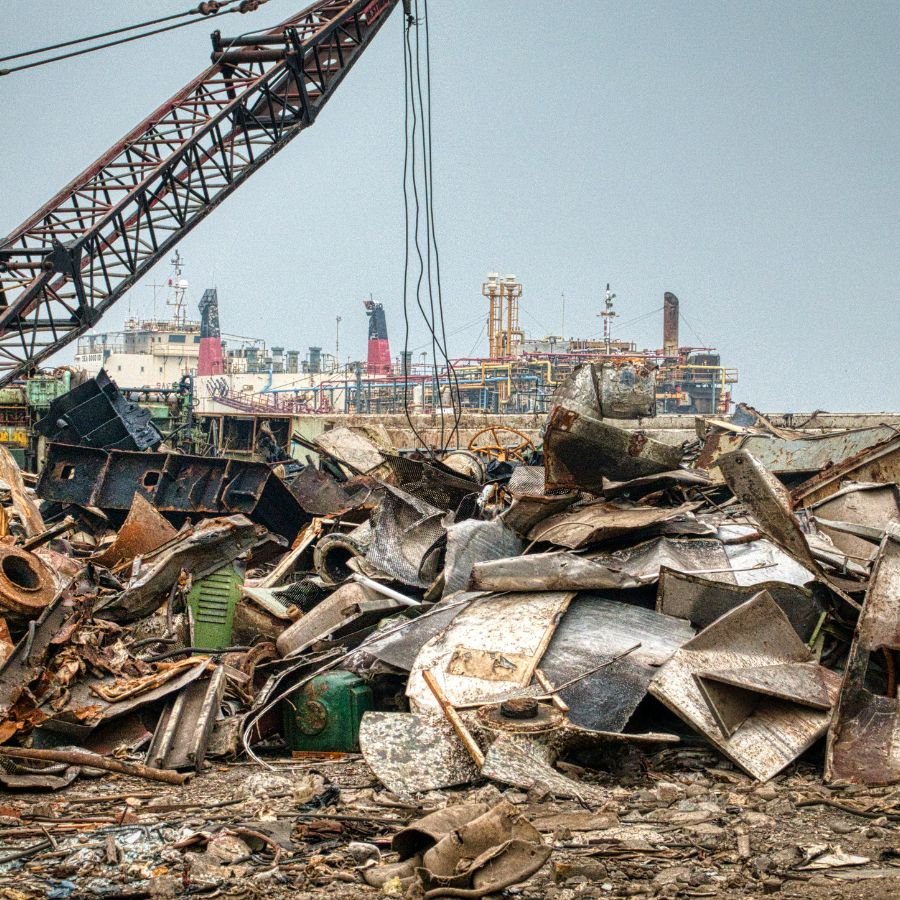The fight against climate change has never been more urgent. As industries worldwide search for ways to reduce greenhouse gas emissions, one surprisingly effective solution often goes unnoticed—scrap metal recycling.
Metal production contributes significantly to global CO₂ emissions, with steel, aluminum, and copper manufacturing responsible for nearly 8% of global emissions. However, recycling these metals can dramatically reduce both energy use and carbon output.
This article explores how scrap metal recycling supports environmental sustainability, lowers emissions, and fuels the transition toward a circular economy.
Understanding the Environmental Impact of Metal Production
The Carbon Cost of Virgin Metal Extraction
Producing metals from raw ore is an energy-intensive process. Mining operations, smelting, and refining require large amounts of fossil fuels, contributing to pollution and deforestation. For instance, producing one ton of aluminum from bauxite generates up to 12 tons of CO₂ emissions, while steel production emits about 1.9 tons of CO₂ per ton of steel produced.
Beyond emissions, mining also destroys ecosystems and consumes massive water resources. As demand for metal continues to rise, the environmental toll of virgin extraction becomes increasingly unsustainable.
The Lifecycle of Metals: From Ore to Product
From mining and transport to refining and manufacturing, every stage of virgin metal production emits greenhouse gases. When compared to recycled metal—which skips many of these steps—the lifecycle emissions difference becomes clear.
A simplified lifecycle analysis shows that recycled aluminum, copper, and steel can cut emissions by up to 95%, 85%, and 60%, respectively, compared to producing new materials.
Scrap Metal Recycling: A Sustainable Alternative
What Is Scrap Metal Recycling?
Scrap metal recycling involves collecting, sorting, and processing discarded metal products for reuse. The process covers both ferrous metals (iron and steel) and non-ferrous metals (aluminum, copper, brass, etc.).
Instead of extracting and refining new ores, recyclers melt down existing metals and purify them for reuse in manufacturing.
Energy Savings Through Recycling
Recycling metal consumes far less energy than primary production. For example:
-
Recycling aluminum uses 95% less energy than making new aluminum from bauxite.
-
Recycling steel saves 60–74% of the energy compared to virgin steelmaking.
-
Recycling copper saves around 85% of the energy required for new copper.
Lower energy consumption directly translates to reduced fossil fuel burning and fewer carbon emissions—making recycling a key strategy in the global carbon reduction effort.
How Scrap Metal Recycling Reduces Carbon Emissions
Reduced Industrial Energy Demand
Industrial furnaces and smelters run at extremely high temperatures, often powered by coal or natural gas. By using recycled metal, industries can dramatically reduce the need for these high-energy operations.
For instance, if all global steel production switched to recycled sources, emissions could be reduced by over 500 million tons of CO₂ annually—equivalent to taking more than 100 million cars off the road.
Lower Transportation-Related Emissions
Mining operations involve long-distance transportation of ore, adding significant emissions. Recycling, on the other hand, typically occurs in local facilities, minimizing transportation needs and reducing the carbon footprint associated with logistics.
Circular Economy and Emission Offsetting
Recycling supports a circular economy, where materials remain in use rather than being discarded. By extending the lifespan of metals, the demand for new extraction declines, effectively offsetting future emissions and preserving natural resources.
Waste Diversion from Landfills
Discarded metals that end up in landfills not only waste valuable resources but can also emit toxic gases and leach harmful substances into the soil. Recycling diverts these metals from landfills, reducing methane and other indirect greenhouse emissions.
Broader Environmental and Economic Benefits
Conservation of Natural Resources
Each ton of recycled metal conserves significant amounts of iron ore, coal, and limestone. This not only reduces environmental destruction from mining but also preserves resources for future generations.
Boost to the Green Economy
Scrap metal recycling isn’t just environmentally friendly—it’s economically beneficial. The industry creates thousands of green jobs worldwide, from collection and sorting to advanced recycling technology development.
Reduced Industrial Pollution
Recycling operations emit fewer pollutants and greenhouse gases compared to primary metal production. Cleaner production processes lead to improved air quality and healthier communities.
How Individuals and Businesses Can Contribute
Responsible Sorting and Disposal
Households can play a vital role by segregating metals from regular waste. Simple steps like recycling cans, wires, and old appliances ensure metals reach proper facilities.
Partnering with Certified Scrap Metal Recyclers
Businesses should collaborate with certified recycling centers to ensure their waste metals are processed ethically and efficiently. Choosing accredited recyclers ensures compliance with environmental standards.
Corporate Sustainability and Reporting
Companies can integrate metal recycling into their Environmental, Social, and Governance (ESG) goals. By tracking recycling metrics, they demonstrate environmental accountability and attract eco-conscious customers.
Challenges and Limitations
Contamination in Scrap Streams
Impurities such as paint, coatings, or mixed materials can complicate recycling processes. Advanced sorting technologies are needed to maintain quality and efficiency.
Lack of Infrastructure in Developing Regions
Many developing nations lack efficient recycling systems. Establishing global recycling networks and education programs is crucial for maximizing impact.
Energy Source Dependency
Although recycling uses less energy, the source of that energy matters. If powered by renewable sources, recycling can become virtually carbon-neutral.
The Future of Metal Recycling and Carbon Reduction
Innovations in Recycling Technologies
Emerging technologies—like AI-based metal sorting and plasma furnaces—are making recycling faster, cleaner, and more energy-efficient.
Integration with Renewable Energy
Recycling facilities powered by solar or wind energy can reduce emissions further, creating zero-emission recycling ecosystems.
Policy and Incentives
Governments are increasingly offering carbon credits, subsidies, and tax incentives for companies that adopt sustainable recycling practices, accelerating the transition to a low-carbon economy.
Conclusion: Closing the Loop on Carbon Emissions
Scrap metal recycling is far more than an environmental duty—it’s a powerful climate action tool. By recycling metals, we reduce energy use, lower industrial emissions, and conserve natural resources, all while supporting the circular economy.
Every recycled can, wire, or car part contributes to a cleaner atmosphere and a sustainable future. The path to a low-carbon world begins with responsible recycling today.
Frequently Asked Questions (FAQs)
Q1. How exactly does scrap metal recycling lower carbon emissions?
Recycling metal requires much less energy than producing new metals from raw ore. This energy efficiency leads to fewer fossil fuels burned and less CO₂ released into the atmosphere.
Q2. Which metals provide the most carbon savings when recycled?
Aluminum, copper, and steel are among the most energy-efficient to recycle—recycling aluminum alone saves up to 95% of energy compared to primary production.
Q3. Does recycling metal still produce any emissions?
Yes, but significantly fewer. When powered by renewable energy sources, recycling can be nearly carbon-neutral.
Q4. Can households make a real difference by recycling metal?
Absolutely. When millions of households recycle regularly, the cumulative energy savings and emission reductions are enormous.
Q5. What innovations will make metal recycling greener in the future?
AI-driven sorting, electric-powered furnaces, and renewable-energy recycling plants are transforming metal recycling into a near-zero-emission process.




Leave a Reply